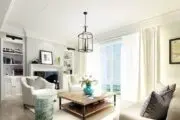

Tip #2: Design with winter weather in mind. “[Mjölk] is an argument for Scandinavian design as a Canadian aesthetic — especially Ontario in particular, because we have a similar climate. In Canada, we suffer from colonialism. We came as a colony and created British-style homes. I like to describe them as ‘oppressive’ because when you see Victorian homes in their pure state they’re very dark, narrow, full of rooms, with little light. These homes really aren’t relevant for our winters. We can look to Scandinavia for inspiration — they’ve had thousands of years to evolve this aesthetic, to make the most of their environment.”
Tip #3: Combat the winter blues with the Danish concept of hygge. “Hygge doesn’t exactly translate well into English. It’s not just coziness, it’s atmospheric. Hygge has an intangible quality — like getting together and using candlelight. I’ve never been to a place that uses more candlelight than Scandinavia. It’s really is about embracing the darkness, rather than working against it by using bright lights.”

Tip #5: Invest in a timeless, three-seater sofa. “The sofa is a foundational piece of furniture. It’s something you use so often. I know when we moved into our place, we were surrounded by boxes. We ordered a pizza, sat down on the sofa and ate. You move everything else away to make room for the sofa — it adds comfort. I would never suggest for someone to buy a big sectional, even if they had the space. A three-seater sofa allows you to have different types of optional seating, like a lounge chair or a daybed. You can get a lot more out of these individual pieces of furniture. As a society, we’re really caught up with adding, with having finished rooms. I don’t think people should rush too much. You just need white walls, a light wood floor and a sofa.”
Tip #6: Prints can liven up your living space. “Many people associate Scandinavian design with a Finnish company called Marimekko — but few understand the significance of the design. Floral motifs are very traditional in Scandinavia because it represents the promise of spring. There’s always a natural element to the prints, they’re never from technology.”
Tip #7: Go easy on the accessories. “A very high quality blanket is something you can have for decades. A 100% wool blanket is the best because wool doesn’t take on odours, and doesn’t absorb and water or spills. You don’t even have to wash it very often. Also, ambient lighting with a dimmer switch. I like keeping my lights low — almost unbearably low — I think that creates a really nice atmosphere.”
Tip #8: Cut the clutter — all of it. “Try to avoid purchasing things — and if you’re moving into a new place, get rid of as much as possible. The best way to eliminate clutter is to see it. We place too much emphasis on storing things away and get accustomed to hiding our clutter. When you can see your mess, it’ll drive you crazy and you’ll want to throw it out. You can’t be tied to possessions — these things exist to serve you, they shouldn’t imprison you. I think a lot of people get overburdened by their stuff. Clutter is a very North American problem that speaks to the disposability of this country. People should probably spend an uncomfortable amount of money on certain items. It should be uncomfortable because you should feel it — that’s what’s going to make you hold on to it longer and take care of it.
If you can go to a big box store and buy most of the things for your home, there’s a huge problem there. We can buy anything we want on credit cards right now, and that’s never happened before. That’s something that’s very ‘now’ — we think we should be able to buy a sofa the day we start looking for one. That’s never happened! That expectation never existed. You always thought about what you were buying and it took years for some people to save up for a single piece of furniture. We’re very in the moment, and people have clutter because they’re buying disposable things.”
Tip #9: Look for inspiration in unexpected places. “My favourite designers are Alvar Aalto, from Finland, and Børge Mogensen, from Denmark. Aalto was very brave and very brilliant. He took a design and brought it to its most simplest form. One of his most famous designs is a three legged stool. It’s so simple but if you change anything, even by a millimetre, it throws off the design completely. Mogensen was also a very driven designer. He’s mid-century, and very true to material. He did very little teak furniture, he wanted to stay true to the native woods in Denmark. This was novel at the time — most people wanted exotic woods and materials. He was a profoundly brilliant designer who inspired many others after him. For inspiration, we go to Scandinavia once or twice a year. It can strike anywhere — at friend’s house, in a hotel lobby, a restaurant — you take an element of that experience and recreate it at home.”
Tip #10: Respect your surroundings. “You can’t really brag to your friends about Scandinavian design, it’s not sexy furniture — there are undertones of modesty and simplicity. If you have neighbours who are caught up with being in style, they won’t be very impressed. It’s something that’s very cultural, which I can relate to. My father’s side is Scottish — they have the same kind of mentality, being frugal and conservative. But that homogenous attitude isn’t really relevant here in Canada anymore. We all come from different places, but inhabit the same landscape. We can’t ignore winter, we’re changing as a country but are forced to abide by nature. Everything is about our landscape, we live in a very striking place.”
All the items featured in this post can be purchased at Mjölk, located at 2959 Dundas Street West in Toronto.











